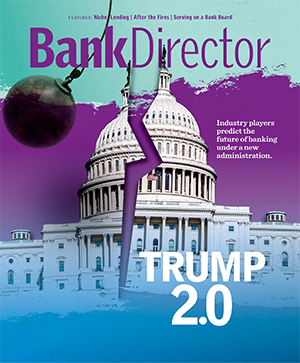
The Bankers’ Chairman
Donald E. Powell keeps a framed article from The New York Times on the wall in his office at the Federal Deposit Insurance Corp., where he has served as the agency’s chairman since 2001. The article, which is dated Jan. 12, 1991, identifies Powell’s old banku00e2u20ac”the First National Bank of Amarillou00e2u20ac”as one of 19 institutions that had received the lowest possible financial rating from Thomson BankWatch, and said it was likely to be closed unless it received financial assistance. This was back in the frightening days of the early 1990s, when a record number of banks and thrifts were taken over by the very same agency that Powell now runs. Texas banks were especially hard hit, starting in the late 1980s when the price of oil plummeted and took a big piece of the state’s economy down with it.
Indeed, all of Texas’s biggest banks were eventually acquired by large, out-of-state banking companies from faraway places like North Carolina, California, and New York. Many of the names on that Thomson Bankwatch list are no longer around either, including the likes of Buffalo, New York-based Goldome, BancOklahoma Corp. in Tulsa, and Amoskeag Bank Shares in Manchester, New Hampshire. The letter that Powell keeps on his wall reminds him that being lucky is good and being smart is better, but having a bulletproof balance sheet is best of all.
Powell, 64, became chairman and chief executive officer at the First National Bank of Amarillo in 1987 when the institution was beginning to struggle under the weight of bad loans, many of them to the devastated oil patch. He managed to get the bank through that difficult periodu00e2u20ac”despite the Thomson warningu00e2u20ac”in large measure because it was well reserved and had enough capital to outlast the downturn. Powell stayed on to run the operation after it was acquired by St. Louis-based Boatmen’s Bancshares in 1993, but left four years later after Boatmen’s was bought by Nationsbank Corp. of Charlotte, North Carolina.
It didn’t take Powell very long to get back into the Amarillo banking market. He quickly put together an investor group and acquired a small bank in a nearby town, and renamed it First National Bank of Amarillo since that name was once again available. Powell served as president and CEO until he was appointed to head up the FDIC.
Powell owes his current position to his close relationship with President George W. Bush. When he was governor of Texas, Bush named Powell to the Board of Regents at Texas A&M University, and Powell later gave considerable money to Bush’s two presidential bids. He is the first banker in recent years (there have been a few others, most recently in 1962) to run the FDIC, and he brings a banker’s perspective to many of the issues financial institutions face today. Powell would agree, for example, with those who argue the industry is overregulatedu00e2u20ac”although he adds that regulation actually has a cyclical nature and things typically even out over time. He says the FDIC, along with the other three bank regulatory agencies, is committed to easing the burden where it can through the simplification of rules.
Powell also is keenly aware of the growing alarm among many community bankers that the adoption of the Basel II capital scheme could place them at a competitive disadvantageu00e2u20ac”a concern that was hardly assuaged by the release of an interagency study last spring suggesting that capital declines at big banks could be much greater than anticipated after the plan has been adopted. Powell says the regulators are determined that small banks will not be placed at a disadvantage.
And while it’s hardly surprising that as chairman of the FDIC he would take a conservative stand on the importance of capital, Powell’s views are deeply influenced by his experience in Texas during the last banking crisis. Without a strong capital base, First National Bank of Amarillo quite possibly would have failed. Paraphrasing Sun Tzu in The Art of War, Powell believes it’s important to place yourself beyond defeat before you go to war. “Capital is the answer to that,” he says.
Bank Director Senior Editor Jack Milligan spoke with Powell in his office at the FDIC, which occupies a prime piece of Washington real estate just two doors down from the White House.
When bankers complain to you that there’s too much regulation, what do they complain about most?
I think that goes in cycles. Normally, it caused them to change their way of doing business or increased the costs associated with regulation. So today, it’s the Bank Secrecy Act and the Sarbanes-Oxley Act. But there are other regulations that involve extra paperwork, like the Truth-in-Lending rules, the Real Estate Settlement Procedures Act, and CRA, that have been with us for a long time. The list is massive. Regulatory burden has always been on the banker’s mind, but at certain times in the business cycle it becomes more of an issue. When things are going good, in terms of the credit cycle, regulatory relief and regulatory burden are more at the forefront. But clearly, the BSA and Sarbanes-Oxley are in the top five. And they would not have been if we were having this discussion two years ago.
Drawing on your perspective as a former banker, do you think the industry is overregulated? Would you feel that way if you were running a bank today?
Yes, I would. Again, I think you have to put it in perspective. Sometimes I had to remind myself when I was in the banking business that we do receive a charter and we have certain subsidies because of that, i.e., FDIC insurance. There’s a certain amount of regulation that we have to put up with, but I think we also benefit from that. I’ve even heard bankers say, “Thank goodness we are regulated or we might get ourselves in trouble.” I kind of fall in the middle of that. When you get into banking you understand it’s a regulated business, but in certain cycles regulators and Congress impose more burden than perhaps is necessary, but it evens itself out. It goes away. Congress and the regulators back off a little bit when they see that.
What can the four regulatory agencies do to lighten the industry’s burden?
Well, as you know, we have an effort going on among the four banking regulators that’s headed up by FDIC Vice Chairman John Reich. Congress had asked at the end of each 10-year period that we reassess all of our regulations, and that process has been going on for some time. We’ve spent a lot of money here at the FDIC attempting to make sure we’re getting it right. We’ve had outreach with those who will be affected u00e2u20ac” consumer groups and the bankers themselves, members of Congress, trade associations. We’ve reached out to lots of folks. We divide regulations into two areas: ones we can’t do anything about, that are law; and some we can do something about as bank regulators. We look at them and ask whether they are still applicable today. Should they be adjusted, after hearing from bankers but also taking into consideration consumer groups that are affected? Has the need for that regulation passed? Is the product even applicable today? I think it’s a healthy process.
Can you provide some examples?
Applications for branches and the time frame for answering questions and applications from bankers in terms of certain things they want to do. That’s an issue that I’ve found at the FDIC that has frustrated me probably as much as anything. We’re slow to act. I think speeding up the process is very, very helpful.
How well has the industry complied with Sarbanes-Oxley?
You need to remember banks have been doing many of the things Sarbanes-Oxley requires since the last banking crisis. Management has had to certify call reports. We’ve required independent auditors and independent directors on audit committees. So the spirit of Sarbanes-Oxley has been alive and well in the banking community for some time. I think there are certain components of Sarbanes-Oxley Section 404 that smaller institutions and larger institutions struggle with. They struggle with the associated costs. And sometimes we, as bank regulators, have not been as good as we should have been in communicating what we think that means. I think we recognize that and we’re doing a lot more in that area.
A recent interagency study of the Basel II plan suggests regulatory capital reductions for large banks that adopt the plan could be more significant than what people had been expecting. Is that likely to push back implementation?
I don’t know. It depends upon the conclusions drawn from the analysis of that study. There are two camps: those that think that, clearly, we’ll push it back because of what it appeares the study reveals and those that think we should go along a parallel track and continue going forward while studying it. The results of that study caught some folks by surprise. We have some people that have studied the whole Basel issue for some time, and I don’t think we were as surprised as some of our fellow regulators were, because we thought capital would, in fact, go down because of these models. It’s a work in progress, but the notion that capital should be based upon risku00e2u20ac”I don’t think there’s any debate about that.
What kind of implementation schedule is realistic at this point?
That’s going to be answered by all of the regulators in a cooperative working environment. Who knows? The study needs to be completed and there will be various thoughts presented, and I’m confident we can come to some satisfactory conclusion.
Do you think implementation of Basel II might create a competitive imbalance between the community banks that aren’t part of that format and the large banks that are?
There are two issues we talk a lot about at the FDIC. One is just what you’ve describedu00e2u20ac”a potential disadvantage smaller institutions would have under a Basel II regime. There is a lot of work that has been done on Basel IA. [Editor’s note: Basel IA as it’s referred to here would be an amended version of Basel I.] It would not surprise me if, in fact, when a final notice is given to the banking industry, that there would be two noticesu00e2u20ac”[including] one for the smaller institutions that would amend Basel I so there would not be any anticompetitive reaction to Basel II. Clearly, all the agencies are committed that Basel II will not have any anticompetitive impact on the smaller institutions.
How would Basel I be amended?
For instance, treating mortgages the same way in the smaller institutions and large institutions when it comes to the amount of capital they must hold against those risks.
What about competition for investors? If you’re able to operate with less capital you’re going to get the higher return on equity, and that is something investors look at.
It’s a factor, but it’s only one factor. I don’t think there’s a manager in the world who wants to operate in an unsafe and unsound way. At the same time, the pressure of return on equity is always thereu00e2u20ac”that’s the marketplace. But I think the equities market recognizes it is only one factor. If I’m an investor in an institution, I want to be sure that institution has enough capital for tomorrow, and for the next day. And there are opportunities that come aboutu00e2u20ac”acquisitionsu00e2u20ac”where you better have capital and you’ve got to have more than minimum capital. There is always the unexpected, and you’ve got to have more than minimum capital. The analytic models in Basel II that do not encompass all the risks associated with running an institutionu00e2u20ac”whole bank interest rate risk, reputation risk, liquidity risku00e2u20ac”all those issues are very important. Investors don’t want management to go with the lowest amount of capital possible. They want management to manage, and that means you’ve got to make sure you’re calibrating your capital for all of the issues, not just return on equity. You’ve got to live for another day.
Do you see Basel II changing the way you supervise banks?
Yes, I think it will. As you know, there are three pillars in Basel II and the second one is supervisory oversight. I think we as regulators have to get up to speed just like the banks have in the way in which they’ve developed their models. We have to make sure we have a complete understanding of the sophisticated models in these larger institutions.
Because you’ll have to actually approve the models they use, right?
That’s right. It’s hard to approve something you don’t understand.
Are you confident the FDIC would be prepared to deal with a distressed institution of very great size?
I hope we don’t have to answer that question. But notwithstanding that, yes. That’s something we constantly have to work at. And we have a team that does nothing but assess our preparedness as it relates to the potential of a larger institution getting into trouble.
What aspects of deposit insurance reform would you like to see? What do you consider to be important and why?
There are certain components of deposit insurance reform that there’s no debate over, like merging the two insurance funds. [Editor’s note: The FDIC maintains separate deposit insurance funds for banks and thrifts.] The thing that gets all the stakeholders’ emotions going is the indexing issue. We’re very clear here at the FDIC that we believe the $100,000 coverage limit should be indexed to the rate of inflation; that $100,000 serves us well but it continues to be diluted because of inflation, and we don’t think that is good public policy. So the best way to address that issue is to index it.
The most important issues to me are as follows. As you know we have these rigid benchmarks, and we’re approaching one right now. [Editor’s note: The FDIC is required by law to raise insurance premiums for the funds when their reserve ratios fall below 1.25% of total industry deposits. This is known as the designated reserve ratio. The agency is facing the prospect of a premium increase now despite the industry’s excellent health, in part because of a surfeit of de novo institutions that have brought new deposits into the banking system.] Everybody would agree the industry is perhaps in the best shape it’s been for many, many years. In fact, there’s something like 83 problem institutionsu00e2u20ac”the lowest since we began keeping track of it. But we’re right on the very edge of having to charge premiums now, and that doesn’t make sense.
Because?
We’re right at 1.25% now because deposits are growing. I think it would be better if the FDIC were able to manage that process with premium collars at the high end and low end to make sure you don’t go crazy either way. But we should be able to act like an insurance companyu00e2u20ac”by looking at the risk out there and then managing the funds within those ranges. Also the premiums should be based upon the risk profile of that institution. It should be more fine-tuned about what you pay. And all should pay. I chartered a bank before I came up here, and we were in existence three years, had the FDIC seal on the door, and didn’t have to pay for it. I don’t know of an insurance product that’s free. [Editor’s note: If the insurance funds exceed their 1.25% designated ratios at the time newly chartered institutions are formed, they are not required to pay insurance premiums and the coverage is essentially subsidized by the rest of the industry.] So there’s lots of things about the current deposit insurance system that to me is not good public policy and doesn’t make good business sense.
It often seems difficult to get Congress to focus on financial regulation unless …
There’s a crisis.
Yes, when there’s actually smoke in the air.
I think you’re right, and thus, we haven’t had a bill. It has passed in the House for the last few years, overwhelmingly. I think there were only 10 nos last time in the House; but it usually gets bogged down in the Senate.
What is the problem there?
I think it’s a coverage issue.
The Senate feels that it’s simply too much largess?
Yes. It’s the coverage issue and also the moral hazard issue.
What are its prospects for passage this year in the Senate?
It depends on who you talk to. It’s hard to be very optimistic when you’ve had two strikes and this is the third time at bat. But we have to be optimistic; we’ll continue to push and shove and hopefully we’ll pass this thing.
There’s been a lot of discussion in recent years about a real estate bubble. Is that something the FDIC is concerned about, given how active banks have become in the home mortgage market?
We just recently published a joint statement with all the agencies about home equity loans, alerting the marketplace that we do have some concern about the underwriting of home equity loans and their liberal terms. It really gets back to the value of the home because we wouldn’t have any problem with some of those issues if we thought the value was going to continue to go up forever. The FDIC also just published a study about the housing bubble. The whole issue is interest rates. We’ve all been a beneficiary of lower interest rates for an extended period of time. I can remember when
I was in the banking business, you’d pay a lot more principal back at a lower interest than with a higher interest. You buy more house at lower interest rates. Interest rates tweaking up gets everybody’s attention. Just today I heard the story of a person who worked in a cafeteria and bought a home three years ago, paid a $155,000 for it, and sold it this week for $400,000. The market gives you those types of opportunities very rarely. Most of the time that signals the market may be top-heavy. A lot of it depends upon stuff we don’t know about today. If there’s an international crisis, if oil and gas prices continue to go up instead of coming downu00e2u20ac”it’s always something we don’t know.
When you examine an institution, do you pay any closer attention now to its residential real estate lending practices?
Absolutely, and when you’ve had this kind of price appreciation, it causes you to focus more on that segment of asset growth. And so you look at underwriting. Are the fundamentals still there? There’s always temptation for banks to follow the herd.
Switching to corporate governance, what does the FDIC want to see out of independent directors?
Common sense.
You answered that a little too quickly, which makes me wonder if you think there hasn’t been a lot of common sense exercised in the boardroom.
I think judgment has been there since the banking crisis in the early 1990s. Prior to the crisis, independent directors tended to go along to get along. They were all friends, and no one wanted to be the person who caused a stink in the boardroom. But that changed with the crisis, and directors today take their responsibilities very, very seriously. I meet with a lot of banks and with a lot of bank directors, and I’ve found they are prepared. They have been trained and they’re not timid; they speak up. I think most bank directors today understand their fiduciary role and take it very, very seriously. They may not be able to answer everything, but again, it’s common sense.
What were you doing in the early 1990s?
I was at the First National Bank of Amarillo. There would be those who might say the bank was running me (laughs).
What was the bank’s experience through the crisis in the early ’90s?
It was terrible. It was like watching something fade away or come close to death, and you try to do everything you can and can’t help it. Ours was a typical bank, I think, in West Texas. It had been there for 100 years, had had record earnings for the previous seven years, increasing dividends, and so forth. But we became lax in certain areas. We loaned against lots of commoditiesu00e2u20ac”oil and gas, cattle. Real estate was part of that. At least in Texas, we were all under the impression that these prices were going to continue to go up forever. And if you made a mistake, it corrected itself the next day. There were a lot of competitive pressures [in the sense that] “We’ve got to make this deal or our competitor will make it.” And times were good.
Then the perfect storm came, and it was hard to grapple with that. And looking back on it, you can clearly see some of the mistakes that were made. But I will tell you there wasn’t anybody who could have forecasted some of the things that happened. That’s not just talked about, that’s real. The oil market corrected itself, and we didn’t adjust quickly. We made a lot of mistakes in judgment.
What did you learn from that?
I learned the only thing that saves you is capital. Good management just goes so far. Technology just goes so far. The regulators just go so far. It’s capital. The Art of War says put yourself beyond defeat before you go to war. Capital is the answer to that.
So you would not agree with eliminating the minimum leverage ratio requirement for the large banks that comply with Basel II?
I would not.
Has your experience as a banker enabled you to make a difference at the FDIC?
From my perspective, it has clearly been an extraordinary advantage. I’ve said that before you can be a bank regulator you should have to be a banker, and before you can be a banker you should have to be a bank regulator. I’ve learned since I’ve come here that there’s always two sides to the story. As a banker, I had one perspective, and my perception of the FDIC was wrong in some areas. At the same time, I think it would be good for the FDIC folks to get into the banking business and view it from that perspective.
How much longer will you be in this job?
My term as chairman expires in 2006. And my term on the FDIC board is until 2007. Who knows?
Would you like to retire?
Absolutely not. I can’t.
So you’ll continue to do something?
I have to. My wife told me she married for better and for worseu00e2u20ac”but not for lunch every day. |BD|

Join OUr Community
Bank Director’s annual Bank Services Membership Program combines Bank Director’s extensive online library of director training materials, conferences, our quarterly publication, and access to FinXTech Connect.
Become a Member
Our commitment to those leaders who believe a strong board makes a strong bank never wavers.

